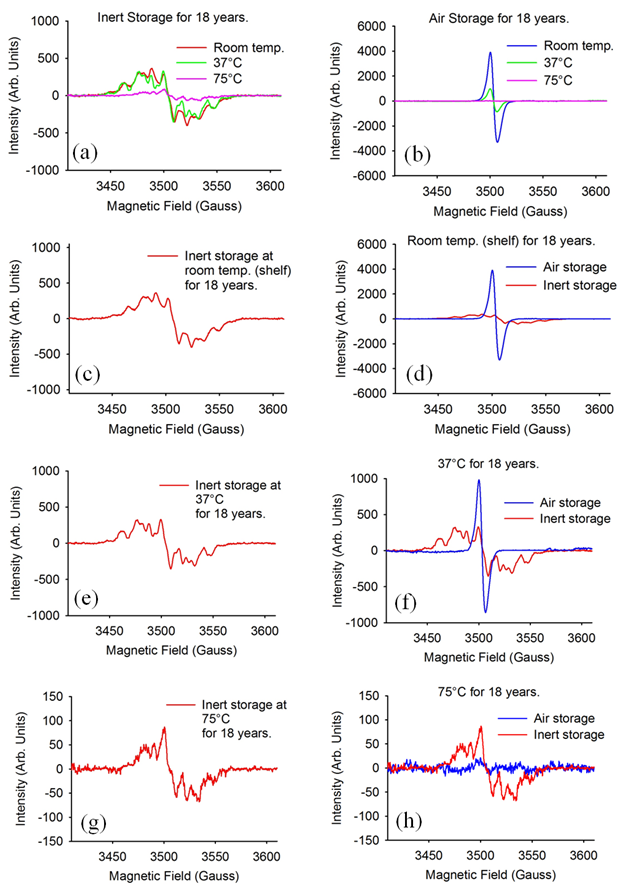Introduction: Ultra-high molecular weight polyethylene (UHMWPE) components of medical devices are often stored on a shelf in inert-sealed packaging for various time periods. These UHMPWE components may contain free radicals, especially if gamma-sterilized, which may react with oxygen, leading to oxidation, wear, and resulting osteolysis. Free radicals in UHMWPE components and their changing status over time is therefore of interest. We have observed such gamma-irradiated medical grade UHMWPE in different environments for 18 years, using electron spin resonance (ESR) for free radical analyses. To our knowledge, this is the first report of radiation-induced radical activity over 18 years in UHMWPE.
Materials and Methods: This project was initiated 18 years ago under the sponsorship of the NSF Center for Industry-University Collaborative Research on Biosurfaces and the State University of New York (SUNY) at Buffalo. Solid UHMWPE samples (GUR4150 and Hylamer) were gamma-irradiated to 30kGy in inert environments (nitrogen, argon, and vacuum-sealed) and in air, then stored for 18 years at 23°C , 37°C, and 75°C. Free radical activities were analyzed using an X-band Bruker EMX spectrometer.
Results and Discussion: One of the main obervations was the presence of primary radicals in all materials in inert environments for 18 years (Fig.1(a)). The quantities of these radicals were about 10% of that first detected upon initial measurements 18 years prior. The samples stored at 37°C did not show a great reduction in radical content as compared to the samples stored at room temperature (23°C) (Fig. 1(c v.s e)). Overall, all samples stored in inert environments did not vary greatly in structural change of ESR spectra (Fig. 1(c,e,g)), but those stored at 75°C (Fig. 1(g)) were much less in quantity. Changes due to temperature or environment did not vary significantly among type of inert storage (nitrogen, argon, or vacuum), or among polyethylene type (GUR4150 vs Hylamer).
For samples stored in air, ESR spectra indicated complete formation to oxygen-induced radicals from primary radicals, as indicated by the single line of all spectra in Fig. 1(b) and the blue lines of Fig. 1(d,f,h). These quantities of oxygen-induced radicals decreased greatly at higher temperatures, with no detectable quantities for samples stored in air for 18 years at 75°C (Fig 1(b) and (h)).
Conclusion: The radical signatures in all inert-stored samples were those of polyethylene molecules (primarily allyl) that had not reacted with oxygen. The radical quantities decreased over the years without significant change in radical type. This decreased quantity of such radicals is, then, likely due to polyethylene radicals reacting among themselves, which could further crosslinking with time. So, crosslink density may theoretically be increased for a given radiation exposure via a “resting period” at slightly elevated temperatures. This could be of interest for antioxidant-blended UHMWPE, in which desired crosslink densities are difficult to achieve - due to antioxidants such as vitamin E's tendency to inhibit crosslinking.

Fig. 1. Irradiated UHMWPE stored in inert and air environments for 18 years, as described in the Results and Discussion.